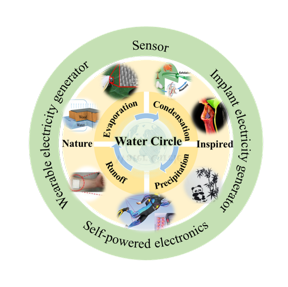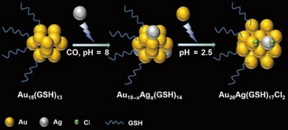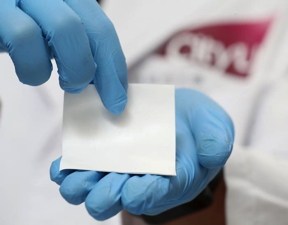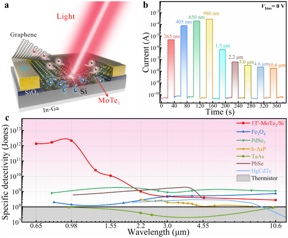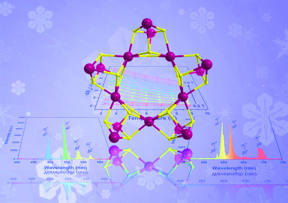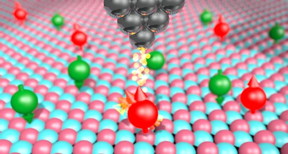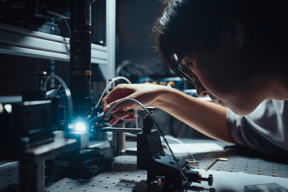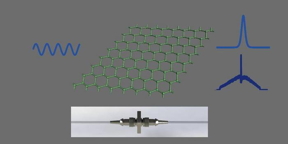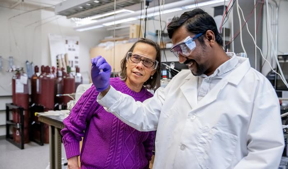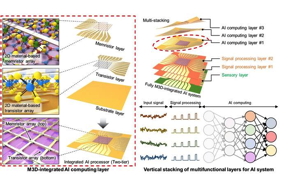Home > Press > Unveiling the quantum dance: Experiments reveal nexus of vibrational and electronic dynamics: Coupling of electronic and nuclear dynamics revealed in molecules with ultrafast lasers and X-rays
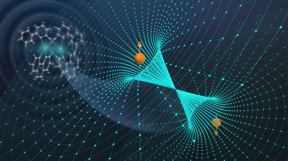 |
| A molecule with two platinum atoms absorbs a photon and starts to vibrate. The vibration enables the molecule’s electron spin to flip, allowing the system to simultaneously change electronic states in a phenomenon called inter-system crossing. (Image by Ellen Weiss.) |
Abstract:
Nearly a century ago, physicists Max Born and J. Robert Oppenheimer developed an assumption regarding how quantum mechanics plays out in molecules, which are comprised of intricate systems of nuclei and electrons. The Born-Oppenheimer approximation assumes that the motion of nuclei and electrons in a molecule are independent of each other and can be treated separately.
Unveiling the quantum dance: Experiments reveal nexus of vibrational and electronic dynamics: Coupling of electronic and nuclear dynamics revealed in molecules with ultrafast lasers and X-rays
Lemont, IL | Posted on July 21st, 2023
This model works the vast majority of the time, but scientists are testing its limits. Recently, a team of scientists demonstrated the breakdown of this assumption on very fast time scales, revealing a close relationship between the dynamics of nuclei and electrons. The discovery could influence the design of molecules useful for solar energy conversion, energy production, quantum information science and more.
“Understanding the interplay between the spin-vibronic effect and inter-system crossing could potentially lead to new ways to control and exploit the electronic and spin properties of molecules.” — Lin Chen, Argonne Distinguished Fellow and professor of chemistry at Northwestern University
The team, including scientists from the U.S. Department of Energy’s (DOE) Argonne National Laboratory, Northwestern University, North Carolina State University and University of Washington, recently published their discovery in two related papers in Nature and Angewandte Chemie International Edition.
“Our work reveals the interplay between the dynamics of electron spin and the vibrational dynamics of the nuclei in molecules on superfast time scales,” said Shahnawaz Rafiq, a research associate at Northwestern University and first author on the Nature paper. “These properties can’t be treated independently — they mix together and affect electronic dynamics in complex ways.”
A phenomenon called the spin-vibronic effect occurs when changes in the motion of the nuclei within a molecule affect the motion of its electrons. When nuclei vibrate within a molecule — either due to their intrinsic energy or due to external stimuli, such as light — these vibrations can affect the motion of their electrons, which can in turn change the molecule’s spin, a quantum mechanical property related to magnetism.
In a process called inter-system crossing, an excited molecule or atom changes its electronic state by flipping its electron spin orientation. Inter-system crossing plays an important role in many chemical processes, including those in photovoltaic devices, photocatalysis and even bioluminescent animals. For this crossing to be possible, it requires specific conditions and energy differences between the electronic states involved.
Since the 1960s, scientists have theorized that the spin-vibronic effect could play a role in inter-system crossing, but direct observation of the phenomenon has proven challenging, as it involves the measurement of changes in electronic, vibrational and spin states on very fast time scales.
“We used ultrashort laser pulses — down to seven femtoseconds, or seven millionths of a billionth of a second — to track the motion of nuclei and electrons in real time, which showed how the spin-vibronic effect can drive inter-system crossing,” said Lin Chen, an Argonne Distinguished Fellow, professor of chemistry at Northwestern University and co-corresponding author on both studies. “Understanding the interplay between the spin-vibronic effect and inter-system crossing could potentially lead to new ways to control and exploit the electronic and spin properties of molecules.”
The team studied four unique molecular systems designed by Felix Castellano, a professor at North Carolina State University and co-corresponding author on both studies. Each of the systems is like the other, but they contain controlled, known differences in their structures. This allowed the team to access slightly different inter-system crossing effects and vibrational dynamics to get a fuller picture of the relationship.
“The geometrical changes that we designed into these systems caused the crossing points between the interacting electronic excited states to occur at slightly different energies and under different conditions,” said Castellano. “This provides insight for tuning and designing materials to enhance this crossing.”
Induced by vibrational motion, the spin-vibronic effect in the molecules altered the energy landscape within the molecules, increasing the probability and rate of inter-system crossing. The team also discovered key intermediate electronic states that were integral to the operation of the spin-vibronic effect.
The results were predicted and bolstered by quantum dynamics calculations by Xiaosong Li, a professor of chemistry at the University of Washington and laboratory fellow at DOE’s Pacific Northwest National Laboratory. “These experiments showed very clear, very beautiful chemistry in real time that aligns with our predictions,” said Li, who was an author on the study published in Angewandte Chemie International Edition.
The profound insights unraveled by the experiments represent a step forward in the design of molecules that can make use of this powerful quantum mechanical relationship. This could prove especially useful for solar cells, better electronic displays and even medical treatments that rely on light-matter interactions.
Both studies were supported by DOE’s Office of Science. The Nature study was supported in part by the National Science Foundation. Experiments in the Angewandte Chemie International Edition were conducted at the Linac Coherent Light Source at DOE’s SLAC National Accelerator Laboratory. Other authors on the Nature study include Nicholas P. Weingartz and Sarah Kromer. Other authors on the paper published in Angewandte Chemie International Edition include Denis Leshchev, Andrew J. S. Valentine, Pyosang Kim, Alexis W. Mills, Subhangi Roy, Arnab Chakraborty, Elisa Biasin, Kristoffer Haldrup, Darren J. Hsu, Matthew S. Kirschner, Dolev Rimmerman, Matthieu Chollet, J. Michael Glownia and Tim B. van Driel.
####
About DOE/Argonne National Laboratory
Argonne National Laboratory seeks solutions to pressing national problems in science and technology. The nation’s first national laboratory, Argonne conducts leading-edge basic and applied scientific research in virtually every scientific discipline. Argonne researchers work closely with researchers from hundreds of companies, universities, and federal, state and municipal agencies to help them solve their specific problems, advance America’s scientific leadership and prepare the nation for a better future. With employees from more than 60 nations, Argonne is managed by UChicago Argonne, LLC for the U.S. Department of Energy’s Office of Science.
The U.S. Department of Energy’s Office of Science is the single largest supporter of basic research in the physical sciences in the United States and is working to address some of the most pressing challenges of our time. For more information, visit https://energy.gov/science .
For more information, please click here
Contacts:
Diana Anderson
DOE/Argonne National Laboratory
Copyright © DOE/Argonne National Laboratory
If you have a comment, please Contact us.
Issuers of news releases, not 7th Wave, Inc. or Nanotechnology Now, are solely responsible for the accuracy of the content.
| Related Links |
| Related News Press |
Quantum Physics
News and information
![]() The present and future of computing get a boost from new research July 21st, 2023
The present and future of computing get a boost from new research July 21st, 2023
![]() Billions of nanoplastics released when microwaving baby food containers: Exposure to plastic particles kills up to 75% of cultured kidney cells July 21st, 2023
Billions of nanoplastics released when microwaving baby food containers: Exposure to plastic particles kills up to 75% of cultured kidney cells July 21st, 2023
![]() Understanding the diverse industrial applications of materials science: Materials Science A Field of Diverse Industrial Applications July 21st, 2023
Understanding the diverse industrial applications of materials science: Materials Science A Field of Diverse Industrial Applications July 21st, 2023
Laboratories
![]() Novel microscope developed to design better high-performance batteries: Innovation gives researchers inside view of how batteries work February 10th, 2023
Novel microscope developed to design better high-performance batteries: Innovation gives researchers inside view of how batteries work February 10th, 2023
Quantum chemistry
![]() Quantum materials: Electron spin measured for the first time June 9th, 2023
Quantum materials: Electron spin measured for the first time June 9th, 2023
![]() IOP Publishing celebrates World Quantum Day with the announcement of a special quantum collection and the winners of two prestigious quantum awards April 14th, 2023
IOP Publishing celebrates World Quantum Day with the announcement of a special quantum collection and the winners of two prestigious quantum awards April 14th, 2023
Physics
![]() IOP Publishing celebrates World Quantum Day with the announcement of a special quantum collection and the winners of two prestigious quantum awards April 14th, 2023
IOP Publishing celebrates World Quantum Day with the announcement of a special quantum collection and the winners of two prestigious quantum awards April 14th, 2023
![]() Diamond cut precision: University of Illinois to develop diamond sensors for neutron experiment and quantum information science April 14th, 2023
Diamond cut precision: University of Illinois to develop diamond sensors for neutron experiment and quantum information science April 14th, 2023
Govt.-Legislation/Regulation/Funding/Policy
![]() The present and future of computing get a boost from new research July 21st, 2023
The present and future of computing get a boost from new research July 21st, 2023
![]() A non-covalent bonding experience: Scientists discover new structures for unique hybrid materials by altering their chemical bonds July 21st, 2023
A non-covalent bonding experience: Scientists discover new structures for unique hybrid materials by altering their chemical bonds July 21st, 2023
Possible Futures
![]() Two types of ultrafast mode-locking operations generation from an Er-doped fiber laser based on germanene nanosheets July 21st, 2023
Two types of ultrafast mode-locking operations generation from an Er-doped fiber laser based on germanene nanosheets July 21st, 2023
![]() Detection of bacteria and viruses with fluorescent nanotubes July 21st, 2023
Detection of bacteria and viruses with fluorescent nanotubes July 21st, 2023
![]() A non-covalent bonding experience: Scientists discover new structures for unique hybrid materials by altering their chemical bonds July 21st, 2023
A non-covalent bonding experience: Scientists discover new structures for unique hybrid materials by altering their chemical bonds July 21st, 2023
![]() Researchers put a new twist on graphite July 21st, 2023
Researchers put a new twist on graphite July 21st, 2023
Discoveries
![]() Billions of nanoplastics released when microwaving baby food containers: Exposure to plastic particles kills up to 75% of cultured kidney cells July 21st, 2023
Billions of nanoplastics released when microwaving baby food containers: Exposure to plastic particles kills up to 75% of cultured kidney cells July 21st, 2023
![]() Understanding the diverse industrial applications of materials science: Materials Science A Field of Diverse Industrial Applications July 21st, 2023
Understanding the diverse industrial applications of materials science: Materials Science A Field of Diverse Industrial Applications July 21st, 2023
![]() A non-covalent bonding experience: Scientists discover new structures for unique hybrid materials by altering their chemical bonds July 21st, 2023
A non-covalent bonding experience: Scientists discover new structures for unique hybrid materials by altering their chemical bonds July 21st, 2023
![]() Researchers put a new twist on graphite July 21st, 2023
Researchers put a new twist on graphite July 21st, 2023
Announcements
![]() Billions of nanoplastics released when microwaving baby food containers: Exposure to plastic particles kills up to 75% of cultured kidney cells July 21st, 2023
Billions of nanoplastics released when microwaving baby food containers: Exposure to plastic particles kills up to 75% of cultured kidney cells July 21st, 2023
![]() Understanding the diverse industrial applications of materials science: Materials Science A Field of Diverse Industrial Applications July 21st, 2023
Understanding the diverse industrial applications of materials science: Materials Science A Field of Diverse Industrial Applications July 21st, 2023
![]() A non-covalent bonding experience: Scientists discover new structures for unique hybrid materials by altering their chemical bonds July 21st, 2023
A non-covalent bonding experience: Scientists discover new structures for unique hybrid materials by altering their chemical bonds July 21st, 2023
Quantum nanoscience
![]() Electron collider on a chip June 30th, 2023
Electron collider on a chip June 30th, 2023
![]() USTC enhances fluorescence brightness of single silicon carbide spin color centers June 9th, 2023
USTC enhances fluorescence brightness of single silicon carbide spin color centers June 9th, 2023
![]() Quantum materials: Electron spin measured for the first time June 9th, 2023
Quantum materials: Electron spin measured for the first time June 9th, 2023
- SEO Powered Content & PR Distribution. Get Amplified Today.
- PlatoData.Network Vertical Generative Ai. Empower Yourself. Access Here.
- PlatoAiStream. Web3 Intelligence. Knowledge Amplified. Access Here.
- PlatoESG. Automotive / EVs, Carbon, CleanTech, Energy, Environment, Solar, Waste Management. Access Here.
- BlockOffsets. Modernizing Environmental Offset Ownership. Access Here.
- Source: http://www.nanotech-now.com/news.cgi?story_id=57367
- :has
- :is
- :not
- ][p
- $UP
- 10
- 10th
- 21st
- 27
- 30th
- 60
- 7th
- 9th
- a
- absorbs
- accelerator
- access
- accuracy
- address
- advance
- affect
- agencies
- ago
- Aligns
- allowed
- Allowing
- also
- altered
- an
- and
- Andrew
- animals
- Announcement
- applications
- applied
- April
- ARE
- Argonne National Laboratory
- AS
- Associate
- assumes
- assumption
- At
- atom
- author
- authors
- b
- Baby
- Bacteria
- based
- basic
- batteries
- BE
- beautiful
- Better
- between
- boost
- born
- both
- Breakdown
- burn
- but
- by
- called
- CAN
- Carolina
- Catalyst
- caused
- celebrates
- Cells
- Center
- Century
- CGI
- challenges
- challenging
- change
- Changes
- chemical
- Chemical processes
- chemistry
- chen
- clear
- click
- Close
- closely
- COHERENT
- collection
- color
- COM
- comment
- Companies
- complex
- Comprised
- computing
- conditions
- conducted
- conducts
- Containers
- content
- control
- controlled
- Conversion
- could
- Cut
- dance
- Darren
- day
- demonstrate
- demonstrated
- Department
- Design
- designed
- designing
- develop
- developed
- Devices
- Diamond
- differences
- different
- direct
- discover
- discovered
- discovery
- displays
- Distinguished
- diverse
- DOE
- down
- dramatically
- drive
- due
- dynamics
- each
- edition
- effect
- effects
- either
- Electronic
- electrons
- employees
- enable
- enables
- end
- energy
- Engines
- enhance
- Enhances
- especially
- Ether (ETH)
- Even
- Every
- excited
- experience
- experiment
- experiments
- Exploit
- Exposure
- external
- FAST
- February
- Federal
- fellow
- field
- First
- Flip
- food
- For
- Forward
- Foundation
- four
- Frequency
- from
- Fuller
- future
- future of computing
- GAS
- generation
- get
- gif
- gives
- greenhouse gas
- Have
- help
- high-performance
- How
- http
- HTTPS
- Hundreds
- Hybrid
- if
- illinois
- image
- important
- in
- Inc.
- include
- Including
- increasing
- independent
- independently
- industrial
- influence
- information
- Innovation
- inside
- insight
- insights
- integral
- interacting
- interactions
- Intermediate
- International
- into
- intrinsic
- involved
- IT
- ITS
- July
- june
- Key
- kidney
- Kills
- Kim
- known
- laboratory
- landscape
- largest
- laser
- lasers
- lead
- Leadership
- li
- light
- like
- limits
- lin
- links
- LLC
- Magnetism
- Majority
- make
- managed
- many
- materials
- matthew
- max
- May..
- measured
- measurement
- mechanical
- mechanics
- medical
- metal
- methane
- Michael
- Microscope
- millions
- mix
- model
- molecular
- molecule
- more
- most
- motion
- municipal
- nanotechnology
- nation
- National
- National Science
- Nations
- Natural
- Natural Gas
- Nature
- net
- New
- news
- nexus
- North
- north carolina
- Northwestern University
- now
- nuclear
- occur
- of
- Office
- on
- operation
- Operations
- or
- Other
- our
- out
- Pacific
- Paper
- papers
- part
- phenomenon
- PHP
- physical
- Physical Sciences
- picture
- plastic
- platinum
- plato
- Plato Data Intelligence
- PlatoData
- Play
- plays
- please
- points
- Pollution
- possible
- Post
- posted
- potentially
- powerful
- Precision
- predicted
- Predictions
- Prepare
- present
- press
- Press Release
- pressing
- prestigious
- probability
- problems
- process
- processes
- Production
- Professor
- profound
- properties
- property
- Prove
- proven
- provides
- published
- Publishing
- put
- Quantum
- quantum information
- Quantum Mechanics
- range
- Rate
- real
- real-time
- recently
- regarding
- related
- relationship
- release
- released
- Releases
- rely
- remove
- represent
- requires
- research
- researchers
- responsible
- Results
- return
- reveal
- Revealed
- revealing
- Reveals
- ROBERT
- Role
- roy
- s
- Said
- Save
- scales
- Science
- Science and Technology
- SCIENCES
- scientific
- Scientific Research
- scientists
- Search
- Second
- Seeks
- sensors
- seven
- Share
- showed
- Silicon
- silicon carbide
- simultaneously
- single
- slightly different
- solar
- Solar cells
- solar energy
- solely
- Solutions
- SOLVE
- some
- Source
- special
- specific
- Spin
- start
- starts
- State
- States
- Step
- studied
- studies
- Study
- submit
- such
- Supported
- supporter
- system
- Systems
- team
- Technology
- Testing
- than
- that
- The
- their
- Them
- These
- they
- this
- those
- Tim
- time
- to
- together
- track
- treated
- treatments
- TURN
- twist
- two
- types
- u.s.
- under
- unique
- United
- United States
- Universities
- university
- university of washington
- unveiling
- us
- use
- used
- Vast
- very
- View
- virtually
- viruses
- Visit
- W
- was
- washington
- Wave
- Way..
- ways
- we
- weiss
- were
- when
- which
- WHO
- wide
- Wide range
- winners
- with
- within
- Work
- working
- works
- world
- Yahoo
- you
- zephyrnet










